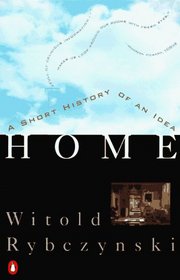Helpful Score: 4
If you think the floorplan of your home is accidental, then this book is for you. Tracing the human concept of "home" in terms of how shelter was designed and how rooms were laid out and for what purpose over the ages, this book takes the reader from the Greek and Roman residences, to medieval and renaissance Europe (in which the furniture was called the "moveables" and the tapestries were the true multi-purpose item to invest in), to Asian cultures in which humans were sitting in chairs long before they were in the Western World. You will never look at your fireplace, your Great Room, or your master suite in quite the same way. Great book!
Helpful Score: 2
From Publishers Weekly
In this study of the evolution of domestic living, McGill University architecture professor Rybczynski traces the material and cultural influences that have helped shape our notions of comfort. PW recommended this "intriguing" book.
Copyright 1987 Reed Business Information, Inc.
From Library Journal
In a loosely configured essay, Rybczynski (Architecture, McGill Univ.) discusses the idea of comfort and the Western cultural attitudes that have shaped it since the end of the middle ages. Rather than dealing with the technical aspects of architecture, he reviews such cultural variables as intimacy and privacy, domesticity, ease, and ideas about light, air, and efficiency as they have changed over time. Essentially Rybczynski makes a plea for the primacy of cultural ideals as a basis for creating psychologically comfortable homes. Though he is selective in his history and examples, this is a worthwhile counterweight to the all-too-common technical practices of modern architects. Recommended. Jack Perry Brown, Ryerson & Burnham Libs., Art Inst. of Chicago
Copyright 1986 Reed Business Information, Inc.
In this study of the evolution of domestic living, McGill University architecture professor Rybczynski traces the material and cultural influences that have helped shape our notions of comfort. PW recommended this "intriguing" book.
Copyright 1987 Reed Business Information, Inc.
From Library Journal
In a loosely configured essay, Rybczynski (Architecture, McGill Univ.) discusses the idea of comfort and the Western cultural attitudes that have shaped it since the end of the middle ages. Rather than dealing with the technical aspects of architecture, he reviews such cultural variables as intimacy and privacy, domesticity, ease, and ideas about light, air, and efficiency as they have changed over time. Essentially Rybczynski makes a plea for the primacy of cultural ideals as a basis for creating psychologically comfortable homes. Though he is selective in his history and examples, this is a worthwhile counterweight to the all-too-common technical practices of modern architects. Recommended. Jack Perry Brown, Ryerson & Burnham Libs., Art Inst. of Chicago
Copyright 1986 Reed Business Information, Inc.
Interesting historical non fiction concerning the evolution of comfort in homes
Mine has this ISBN but is paperback. I just loved this book. I have hoarded too many copies!
This book speaks to everything except what's you guess. It is overly academic, theme-less, and just plain horrible. I'm sorry I ordered it. It's off to Goodwill. It's not even worth the postage to list it on Paperbackswap.




![header=[] body=[Get a free book credit right now by joining the club and listing 5 books you have and are willing to share with other members!] Help icon](/images/question.gif?v=90afaeb39)
